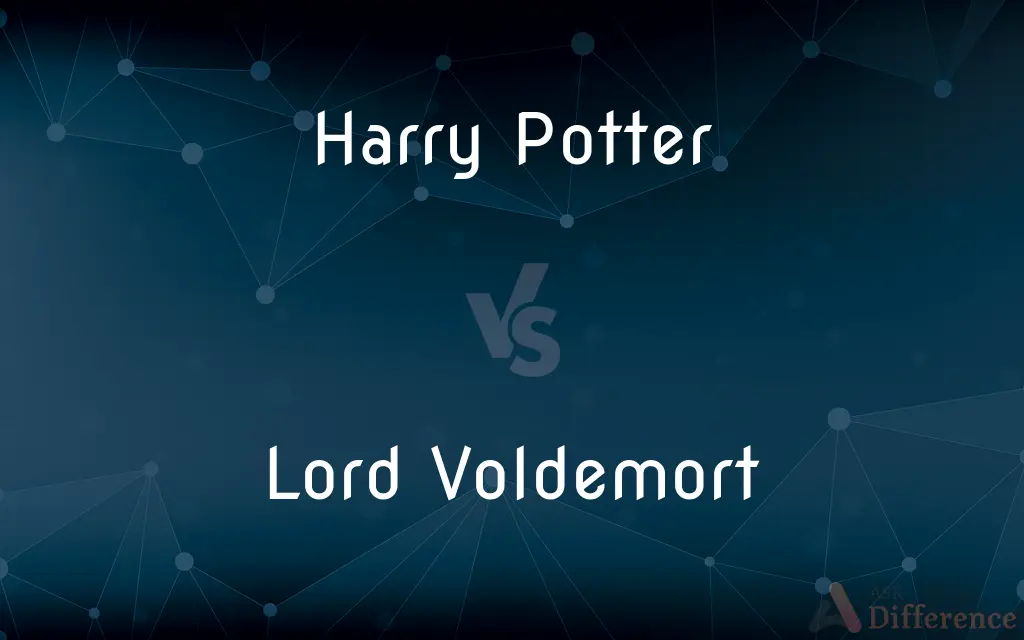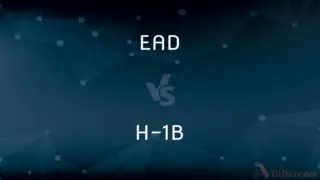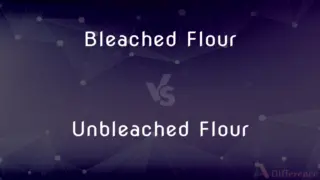Harry Potter vs. Lord Voldemort — What's the Difference?
By Tayyaba Rehman — Published on February 13, 2024
Harry Potter is the protagonist in J.K. Rowling's series, symbolizing hope and courage. Lord Voldemort, the main antagonist, represents dark magic and seeks immortality through Horcruxes.

Difference Between Harry Potter and Lord Voldemort
Table of Contents
ADVERTISEMENT
Key Differences
Harry, born to magical parents, discovers his wizard identity at 11. Known for bravery, loyalty, and the lightning-shaped scar from Voldemort's failed curse, he faces adversities, forming enduring friendships.
Once Tom Riddle, he delves into dark magic, becoming Voldemort. His obsession with immortality leads to creating Horcruxes. As a dark wizard, he embodies fear, hatred, and opposes Harry in the battle of good versus evil.
Comparison Chart
Role
Protagonist, symbol of hope
Antagonist, embodiment of dark magic
Character Traits
Bravery, loyalty, friendship
Ambition, cruelty, obsession with immortality
Background
Orphan, raised by non-magical relatives
Orphan, discovered magic at a young age
ADVERTISEMENT
Symbolism
Represents hope and courage
Symbolizes dark magic, fear, and hatred
Conflict
Battles against dark forces
Seeks power, immortality, conflicts with Harry
Compare with Definitions
Harry Potter
Known for bravery, loyalty, and friendship.
Harry Potter's character is defined by qualities such as bravery, loyalty, and the enduring bonds of friendship.
Lord Voldemort
Embodies ambition, cruelty, and the pursuit of power.
Lord Voldemort's character is marked by unbridled ambition, cruelty, and an insatiable pursuit of power.
Harry Potter
Lightning-shaped scar from Voldemort's curse.
The lightning-shaped scar on Harry Potter's forehead is a visible reminder of his encounter with the dark wizard.
Lord Voldemort
Symbolizes fear, hatred, and opposes Harry.
Voldemort symbolizes fear and hatred, serving as the primary adversary in the conflict against Harry Potter.
Harry Potter
Discovered his wizard identity at age 11.
At the age of 11, Harry Potter discovered his wizard identity and embarked on a magical journey.
Lord Voldemort
Originated as Tom Riddle, delving into dark arts.
Tom Riddle, who later became Lord Voldemort, delved into dark arts, paving the way for his transformation.
Harry Potter
Faces adversities, forming enduring friendships.
Throughout the series, Harry Potter faces numerous adversities, forging enduring friendships along the way.
Lord Voldemort
Obsession with immortality leads to creating Horcruxes.
Lord Voldemort's obsession with immortality drives him to create Horcruxes, anchoring his existence in dark magic.
Harry Potter
Protagonist symbolizing hope and courage.
Harry Potter, the series' protagonist, symbolizes hope and courage in the face of adversity.
Lord Voldemort
Antagonist embodying dark magic.
Lord Voldemort serves as the series' antagonist, embodying the darkest aspects of magic.
Common Curiosities
How does Harry symbolize hope in the series?
Harry symbolizes hope through his courage, resilience, and determination to stand against the forces of darkness.
When did Harry Potter discover his wizard identity?
Harry Potter discovered his wizard identity at the age of 11.
What was Lord Voldemort's original name?
Lord Voldemort's original name was Tom Riddle.
What is the significance of Harry's lightning-shaped scar?
Harry's lightning-shaped scar is a visible mark from Voldemort's failed curse, symbolizing their connection and Harry's resilience.
Why is Lord Voldemort obsessed with immortality?
Voldemort's obsession with immortality stems from his fear of death and desire for ultimate power.
How does Harry's friendship impact the series?
Harry's friendships, particularly with Ron and Hermione, play a crucial role in supporting him emotionally and overcoming challenges.
What makes Harry's character relatable?
Harry's relatability lies in his vulnerabilities, struggles, and the universal themes of friendship, love, and the battle between good and evil.
What is the conflict between Voldemort and Harry?
The conflict centers on the battle between good and evil, with Harry opposing Voldemort's dark forces to protect the wizarding world.
What are Horcruxes, and why did Voldemort create them?
Horcruxes are objects containing a piece of the wizard's soul, ensuring immortality. Voldemort created them to safeguard against death.
How does Harry's upbringing influence his character?
Raised by non-magical relatives, Harry's challenging upbringing contributes to his humility, empathy, and the ability to withstand adversity.
What qualities define Lord Voldemort as a dark wizard?
Lord Voldemort is characterized by ambition, cruelty, a lack of empathy, and the use of dark magic for destructive purposes.
What role does Harry play in the wizarding world?
Harry serves as a symbol of resistance against dark forces, uniting the wizarding world against tyranny.
Why is Voldemort feared in the wizarding world?
Voldemort is feared for his ruthlessness, dark magic prowess, and his quest for dominance, instilling terror among wizards and witches.
How does Voldemort's pursuit of power drive the narrative?
Voldemort's relentless pursuit of power fuels the overarching conflict, leading to confrontations with Harry and the wizarding community.
How does Harry's character evolve throughout the series?
Harry undergoes significant growth, evolving from a young wizard discovering his identity to a courageous leader standing against dark forces.
Share Your Discovery

Previous Comparison
EAD vs. H-1B
Next Comparison
Bleached Flour vs. Unbleached FlourAuthor Spotlight
Written by
Tayyaba RehmanTayyaba Rehman is a distinguished writer, currently serving as a primary contributor to askdifference.com. As a researcher in semantics and etymology, Tayyaba's passion for the complexity of languages and their distinctions has found a perfect home on the platform. Tayyaba delves into the intricacies of language, distinguishing between commonly confused words and phrases, thereby providing clarity for readers worldwide.











































